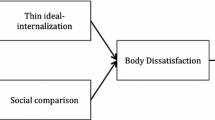Abstract
This research investigated several characteristics of the cognitions of 15 bulimics, 15 repetitive dieters, and 15 nonbulimic, nondieting women using an in vivo thought-sampling procedure. Following training, subjects self-monitored their thoughts every 30 min for two randomly selected days. Subjects' cognitions were rated by independent raters on content, affective tone, accuracy, and adherence to a dichotomous thinking style. Results indicated bulimics reported significantly greater proportions of eating- and weight-related thoughts than non-eating-disordered control subjects and significantly greater proportions of negative affective thoughts than repetitive dieters and non-eating-disordered control subjects. Furthermore, bulimics were significantly more likely to report distorted eating- and weight-related thoughts than the remaining groups. While bulimics were not significantly more preoccupied with thoughts of food independent of eating, thoughts of weight and body shape composed a significantly greater proportion of their eating- and weight-related thoughts than those of the remaining groups. Theoretical and clinical implications of these findings are discussed.
Similar content being viewed by others
References
American Psychiatric Association. (1980).Diagnostic and statistical manual of mental disorders (3rd ed.). Washington, DC: Author.
American Psychiatric Association. (1987).Diagnostic and statistical manual of mental disorders (3rd ed., revised). Washington, DC: Author.
Beck, A. T., Rush, A. J., Shaw, B. F., & Emery, G. (1979).Cognitive therapy of depression. New York: Guilford Press.
Cacioppi, J. T., & Petty, R. E. (1981). Social psychological procedures for cognitive response analyses: The thought-listing technique. In T. V. Merluzzi, C. R. Glass, & M. Genest (Eds.),Cognitive assessment (pp. 309–342). New York: Guilford Press.
Drewnowski, A., Yee, D. K., & Krahn, D. D. (1988). Bulimia in college women: Incidence and recovery rates.American Journal of Psychiatry, 145 753–755.
Dykens, E. M., & Gerrard, M. (1986). Psychological profiles of purging bulimics, repeat dieters, and controls.Journal of Consulting and Clinical Psychology, 54 283–288.
Fairburn, C. G. (1980). Self-induced vomiting.Journal of Psychosomatic Research, 24 193–197.
Fairburn, G. C. (1985). Cognitive-behavioral treatment for bulimia. In D. Garner & P. Garfinkel (Eds.),Handbook of psychotherapy for anorexia nervosa and bulimia. New York: Guilford Press.
Gormally, J., Black, S., Daston, S., & Rardin, D. (1982). The assessment of binge eating severity among obese persons.Addictive Behaviors, 7 47–55.
Hawkins, R. C., II, & Clement, P. F. (1984). Binge eating: Measurement problems and a conceptual model. In R. C. Hawkins, II, W. J. Fremouw, & P. F. Clement (Eds.),The binge-purge syndrome: Diagnosis, treatment, and research (pp. 229–253). New York: Springer.
Hollon, S. D., & Kendall, P. C. (1981). In vivo assessment techniques for cognitive-behavioral processes. In P. C. Kendall & S. D. Hollon (Eds.),Assessment strategies for cognitive-behavioral interventions (pp. 319–362). New York: Academic Press.
Hunt, D. A., & Rosen, J. C. (1981). Thoughts about food by obese and nonobese individuals.Cognitive Therapy and Research, 5 317–322.
Hurlburt, R. T., & Sipprelle, C. N. (1978). Random sampling of cognitions in alleviating anxiety attacks.Cognitive Therapy and Research, 2 165–169.
Katzman, M. A., & Wolchik, S. A. (1984). Bulimia and binge eating in college women: A comparison of personality and behavioral characteristics.Journal of Consulting and Clinical Psychology, 52 423–428.
Kendall, P. C., & Hollon, S. D. (1981). Assessing self-referent speech: Methods in the measurement of self-statements. In P. C. Kendall & S. D. Hollon (Eds.),Assessment strategies for cognitive-behavioral interventions (pp. 85–118). New York: Academic Press.
Klinger, E. (1978). Modes of normal conscious flow. In K. S. Pope & J. L. Singer (Eds.),The stream of consciousness: Scientific investigations into the flow of human experience. New York: Plenum Press.
Lingswiler, V. M., Crowther, J. H., & Stephens, M. A. P. (1989). Affective and cognitive antecedents to eating episodes in bulimia an binge eating.International Journal of Eating Disorders, 8(5), 533–539.
Metropolitan Life Insurance Company (1983). Metropolitan height and weight tables. New York: Author. (Available from author, Health and Safety Division.)
Mizes, J. S. (1985). Bulimia: A review of its symptomatology and treatment.Advances in Behavior Research and Therapy, 7 91–142.
Mizes, J. S. (1987).Personality characteristics of bulimic and non-eating disordered female controls: A cognitive behavioral perspective. Paper presented at the Society of Behavioral Medicine, Washington, DC.
Myers, A., Mercatoris, M., & Artz, L. (1976). On the development of a cognitive self-monitoring skill.Behavior Therapy, 7 128–129.
Orleans, C. T., & Barnett, L. R. (1984). Bulimarexia: Guidelines for behavioral assessment and treatment. In R. C. Hawkins, W. J. Fremouw, & P. F. Clement (Eds.),The binge-pure syndrome: Diagnosis, treatment and research. New York: Springer.
Parks, C. W., Jr., & Hollon, S. D. (1988). Cognitive assessment. In A. S. Bellack & M. Hersen (Eds.),Behavioral assessment: A practical handbook (pp. 161–212). New York: Pergamon Press.
Phelan, P. W. (1987). Cognitive correlates of bulimia: The Bulimic Thoughts Questionnaire.International Journal of Eating Disorders, 6 593–607.
Polivy, J., & Herman, C. P. (1985). Dieting and binging: A causal analysis.American Psychologist, 40 193–201.
Russell, G. (1979). Bulimia nervosa: An ominous variant of anorexia nervosa.Psychological Medicine, 9 429–457.
Schlesier-Stropp, B. (1984). Bulimia: A review of the literature.Psychological Bulletin, 95(2), 247–257.
Schulman, R. G., Kinder, B. N., Powers, P. S., Prange, M., & Gleghorn, A. (1986). The development of a scale to measure cognitive distortions in bulimia.Journal of Personality Assessment, 50 630–639.
Thompson, D. A., Berg, K. M., & Shatford, C. A. (1987). The heterogeneity of bulimic symptompatology: Cognitive and behavioral dimensions.International Journal of Eating Disorders, 6 215–234.
Williamson, D. A., Kelley, M. L., Davis, C. J., Ruggiero, L., & Blouin, D. C. (1985). Psychopathology of eating disorders: A controlled comparison of bulimics, obese, and normal subjects.Journal of Consulting and Clinical Psychology, 53 161–166.
Willmuth, M. E., Leitenberg, H., Rosen, J. C., & Cado, S. (1988). A comparison of purging and nonpurging normal weight bulimics.International Journal of Eating Disorders, 1(6), 825–835.
Zotter, D. L. (1988).The role of cognitions in bulimia nervosa. Unpublished master's thesis, Kent State University, Kent, Ohio.
Author information
Authors and Affiliations
Rights and permissions
About this article
Cite this article
Zotter, D.L., Crowther, J.H. The role of cognitions in bulimia nervosa. Cogn Ther Res 15, 413–426 (1991). https://doi.org/10.1007/BF01173035
Issue Date:
DOI: https://doi.org/10.1007/BF01173035




